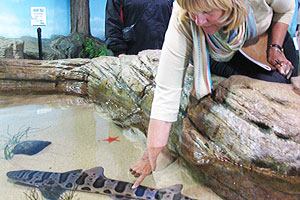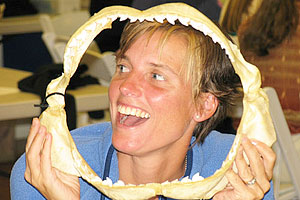 Mary Collins School teacher Blythe Shelley touching
Mary Collins School teacher Blythe Shelley touching
a leopard shark at the Aquarium of the BayThat was the question put to a group of Bay Area teachers-all participants in Watershed Week, The Bay Institute's annual back-to-school teacher-training institute, facilitated by our Students and Teachers Restoring a Watershed (STRAW) Project. At the Aquarium of the Bay, these teachers-turned-students got to see, touch, and learn about some of the creatures that live under that Bay-including the Bay's sharks. They also learned about the Aquarium's shark tagging program, which aims to help us better understand these amazing and elusive animals.
So, how do the Bay's leopard sharks, soupfin sharks, sevengill sharks, spiny dogfish, and other shark species differ from "non-shark" fishes? Here are a few key distinctions:
#1. You could say that sharks don't have a bad bone in their bodies. In fact, sharks don't have any bones in their bodies. Sharks-along with their relatives skates, rays, and ratfish-belong to a diverse class of fish that have cartilaginous skeletons, unlike the bony skeletons of other fish.
#2. Body shape. If you look at most fish head on, they have a generally oval shape. Sharks, in contrast, tend to be more triangular with a wide, flat under-surface. Their broad pectoral fins give them lift as they move through the water, not unlike the wings of an airplane. This hydrodynamic shape is key to keeping sharks afloat (you'll see why as we move on to difference #3).
#3. Besides bones, sharks lack the air-filled swim bladders that most fish use for buoyancy (If sharks are airplanes, does that mean bony fish are hot air balloons?) Instead, sharks keep afloat with the help of a large, low-density liver, their unique body designs, and the physics of forward motion. If a shark stops swimming it won't necessarily drown-only some sharks need to swim to breath-but it will sink!

 Old Adobe Elementary teacher Juliet James examining shark teeth
Old Adobe Elementary teacher Juliet James examining shark teeth